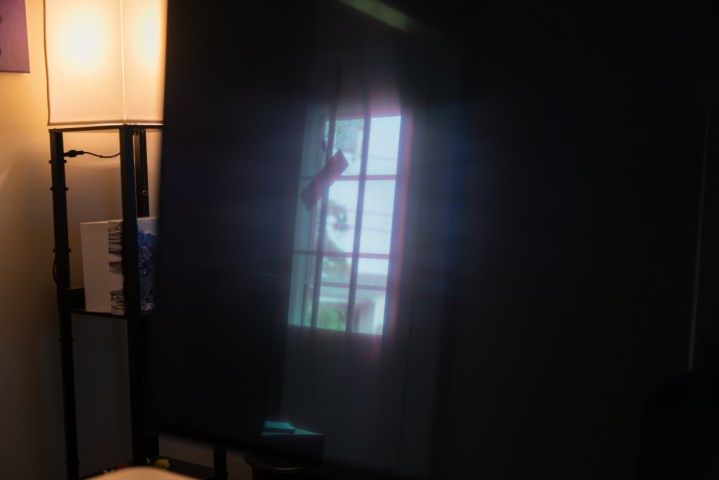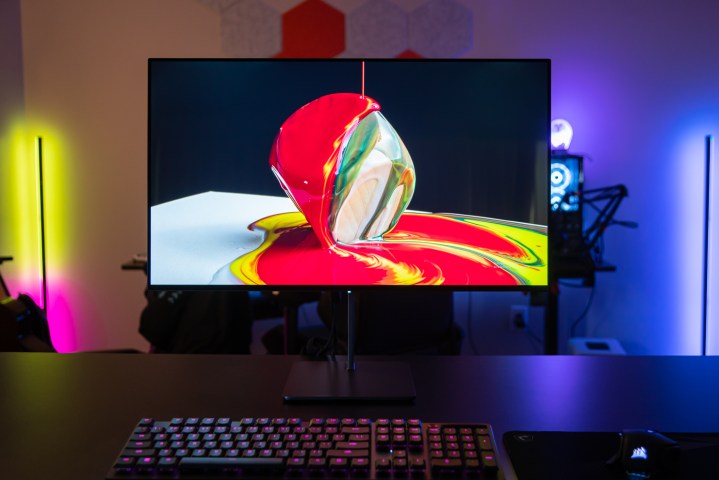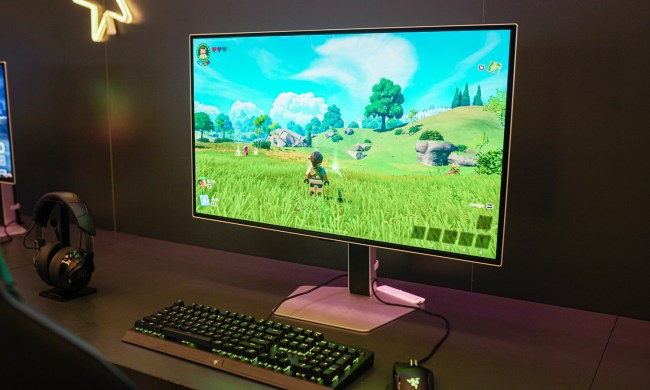Why haven’t we seen a glossy gaming monitor yet? It’s a fair question given that the best gaming monitors are dominated by matte panels, especially when you consider glossy creator displays like Apple’s ProDisplay XDR and LG UltraFine 5K. Matte may be the norm for gaming monitors, but the new Dough Spectrum 4K Glossy proves it may be time for gaming monitors to branch out.
Before getting into it, I need to clarify the whole Dough/Eve situation. The company Eve is now known as Dough, but the Spectrum 4K Glossy is the same monitor the company announced earlier this year. It’s a bit of a strange rebrand given that the company just launched a new monitor, but here we are.
The glaring elephant in the room

Apart from the glossy screen, this new monitor is almost identical to the Eve Spectrum 4K we reviewed last year, and all of my testing is nearly identical to what we found around mid-2021. It packs in all the features you’d expect out of a high-end gaming monitor — 4K at 144Hz, HDMI 2.1, and G-Sync/FreeSync support — but now with a glossy screen. It makes a world of difference, so much so that I plan on using the Spectrum 4K Glossy as my main gaming display moving forward.
Matte screens aren’t bad, and they’re the norm for good reason. They reduce eyestrain, have far less glare, and can resist things like dust and fingerprints. If reflections drive you up the wall or you’re sitting in a particularly bright room, you want a matte monitor. Gloss makes glare an issue.
The Spectrum 4K Glossy has more noticeable glare than a traditional matte monitor, but it’s not nearly as bad as I expected. It’s much less noticeable than an OLED TV, and in some cases, the glare is less significant than even a matte monitor.

Dough didn’t just rip off the matte coating and call it a day. In fact, the company had to work directly with its panel supplier (LG, in case you were wondering) to recalibrate its assembly line to accommodate the manufacturing of the new display. That extra R&D time also went into making a coating to handle potential glare issues. And it works.
You don’t actually see more glare. It’s just more direct and not as diffused as what you’d find on a matte monitor. That ends up being a better viewing experience in darker rooms, as small light sources only cause a small area of glare — not the stretched, diffused glare you’d find on a matte monitor. That’s particularly a plus in color scenes.
Although you’ll notice glare much more in dark scenes on the Spectrum 4K Glossy, it disappears almost entirely when you have a lot of colors going on. The monitor gets so bright (720 nits, based on my testing) that it combats most issues in darker rooms, too. You shouldn’t put the Spectrum 4K Glossy opposite a bright window, but most people won’t notice much glare at all — certainly not enough for it to be a major issue.
Bad HDR on paper, beautiful in practice

The Dough Spectrum 4K Glossy shouldn’t have great HDR. It’s only certified for DisplayHDR 600, and it includes only 16 vertical local dimming zones. That’s identical to the Corsair Xeneon 32 and well below the recently released Sony InZone M9. On paper, the Spectrum 4K Glossy shouldn’t have as good of HDR as it does.
But from the moment I booted up Destiny 2, it was clear: This is the best HDR picture I’ve seen on a monitor. That should show just how powerful the monitor finish is on the final product. The contrast is deep and moody, the colors pop off the screen in a way I’ve never seen before, and the brightness is only rivaled by a display like the Alienware 34 QD-OLED.
Although there are only 16 local dimming zones, they make a huge difference on the Spectrum 4K Glossy. Without a matte finish, the zones that are turned off give the effect of looking at an OLED screen where pure blackness sits at one end of the screen.
I’ve been searching for a monitor that can offer an OLED experience, but the Spectrum 4K Glossy is the first one that’s gotten close.
On the other end, you can see the dimming zones much clearer, unlike the smaller zones available on the Sony InZone M9. That’s a fair trade-off for me. Outside of a dedicated local dimming test, I was never able to spot one zone transitioning to another when actually playing a game or watching a movie.
I’ve been searching for a monitor that can provide anything near the experience of playing a game on a console with my LG C8 OLED (I know I’m a little behind the OLED curve) for nearly four years. The Spectrum Glossy 4K doesn’t match the experience, but it’s the first monitor that’s gotten close.
More than a finish
It’s easy to write off the Spectrum 4K Glossy as just a different monitor finish, especially considering the display alone clocks in at $1,100 ($1,200 if you want the stand). The finish makes a huge difference in how light and color interact with the outer layers of the monitor, though, which brings together the points about color, contrast, and glare that I’ve mentioned.
TftCentral had a look at the display in March, taking some microscopic photos to see the differences between the finishes. The glossy version has better text and image clarity and that’s because the sub-pixels aren’t being filtered through a hazy matte finish. Instead of each of the red, green, and blue sub-pixels slightly fringing on their neighbors, every color is evenly separated.

That makes a huge difference in how vibrant colors look and how clear images and text are, especially on a 4K screen. The Spectrum 4K Glossy may be the same monitor as the matte version on a spec sheet, but make no mistake — it feels like a completely different beast with huge benefits in image quality and HDR.
Glossy gaming monitors aren’t the norm, but the Dough Spectrum 4K Glossy is an argument they should be. Glossy screens shouldn’t replace the many matte options you can buy now, but maybe Dough will kick off a trend where glossy panels are at least an option.



